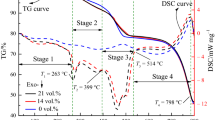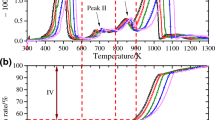Abstract
During fire investigation, gasoline, as a common accelerant, is produced by petroleum cracking. However, the pyrolysis residues of other petrochemicals may interfere with gasoline identification. Polymerised styrene butadiene rubber (SBR) 1502 has combustion characteristics highly consistent with those of gasoline, thus having a great effect on gasoline identification. This study investigated the pyrolysis process of SBR 1502 by using thermogravimetric–differential scanning calorimetry (TG–DSC) and gas chromatography–mass spectrometry (GC–MS) to examine the residues during combustion stages, including pyrolysis and nonpyrolysis stages. The results indicated that 2,3-dimethylnaphthalene in the pyrolysis residues of SBR 1502 in pyrolysis stages 2 and 3 was lacked. However, when SBR 1502 only undergoes the first pyrolysis stage or even earlier (Nonpyrolysis stage), the characteristic components in the residue are similar to gasoline. In addition, mathematical methods were applied to analyse relevance and differences between SBR 1502 and gasoline. The conclusion was that the Pearson product-moment correlation was > 0.990, which may interfere with the identification, and principal component analysis could efficiently distinguish them. The current results can provide an accurate and feasible basis for fire investigation.







Similar content being viewed by others
Abbreviations
- \( F_{\text{i}} \) :
-
Correction factor
- \( n \) :
-
Number of variables
- \( r_{\text{xy}} \) :
-
Correlation coefficient of PPMC
- \( S_{\text{wi}} \) :
-
Percentage of components (%)
- \( S_{\text{i}} \) :
-
Peak area of component
- T 1 :
-
Initial pyrolysis temperature (°C)
- T 2 :
-
Pyrogenic decomposition temperature (°C)
- T 3 :
-
Rapid pyrolysis temperature (°C)
- T 4 :
-
Burnout temperature (°C)
- X :
-
Variables
- \( x \) :
-
Need standardised value
- \( \bar{x} \) :
-
Average of X variables
- \( x_{\text{n}} \) :
-
The nth variable of the X variable
- \( x_{\text{i}} \) :
-
Sample value of X
- Y :
-
Variables
- \( \bar{y} \) :
-
Average of Y variables
- \( y_{\text{n}} \) :
-
The nth variable of the Y variable
- \( y_{\text{i}} \) :
-
Sample value of Y
- \( z \) :
-
Standardised value
- \( \mu \) :
-
Average value
- \( \sigma \) :
-
Standard deviation
- \( \lambda \) :
-
Calculated feature values
- \( \gamma \) :
-
Feature vectors
References
Fan WC. Concise tutorial on fire science. Anhui, PR China: China University of Science and Technology Press; 1995 (in Chinese).
Icove DJ, Haynes GA. Kirk’s fire investigation. 8th ed. New York: Pearson Education; 2018.
Hurley MJ. SFPE Handbook of fire protection engineering. 5th ed. London: Springer; 2016.
Leite RM, Centeno FR. Effect of tank diameter on thermal behavior of gasoline and dieselstorage tanks fires. J Hazard Mater. 2018;342:544–52.
Pitts WM. Improved understanding of thermal agent fire suppression mechanisms from detailed chemical kinetic modeling with idealized surrogate agents. Proc Combust Inst. 2009;32:2599–606.
Abdulrhman MD, Sultan SA, Ahmad HA, Ahmad A. Determination of gasoline residues on carpets by SPME-GC-MS technique. Arab J Sci Eng. 2014;39:6749–56.
Electrical fires. NFPA 921: Guide for fire and explosion investigations. 2017 ed. National Fire Protection Association, USA; 2017.
Muller D, Levy A, Shelef R. Detection of gasoline on arson suspects’ hands. Forensic Sci Int. 2011;206:150–3.
Pert AD, Baron MG, Birkett JW. Review of analytical techniques for arson residues. J Forensic Sci. 2006;51:1033–49.
DeTata D. Forensic sciences-arson residues. In: Reference module in chemistry, molecular sciences and chemical engineering encyclopedia of analytical science, 3rd edn.; 2019.
Stauffer E, Dolan JA, Newman R. Fire debris analysis. New York: Academic Press; 2007.
Montani I, Comment S, Delemont O. The sampling of ignitable liquids on suspects’ hands. Forensic Sci Int. 2010;194:115–24.
Baechler S, Comment S, Delemont O. Extraction and concentration of vapors from fire debris for forensic purposes: evaluation of the use of Radiello passive air sampler. Talanta. 2010;82:1247–53.
Tan B, Hardy JK, Snavely RE. Accelerant classification by gas chromatography/mass spectrometry and multivariate pattern recognition. Anal Chim Acta. 2000;422:37.
Cavanagh K, Pasquier ED, Lennard C. Background interference from car carpets-the evidential value of petrol residues in cases of suspected vehicle arson. Forensic Sci Int. 2002;125:22–36.
Li M, Zhan JH, Lai D, Tian Y, Liu X, Xu G. Study on the evolution characteristic of intermediate during the pyrolysis of oil shale. J Therm Anal Calorim. 2017;130:2227–38.
Hadef Y, Kaloustian J, Nicolay A, Portugal H. Thermal stability evaluation of doping compounds before GC-MS analysis by DSC. J Therm Anal Calorim. 2008;93:553–60.
Wu SH, Chi JH, Wu YT, Huang YH, Chu FJ, Horng JJ, et al. Thermal hazard analysis of triacetone triperoxide (TATP) by DSC and GC/MS. J Loss Prevent Proc. 2012;25:1069–74.
Parker BP, Rajeswaran P, Kirk PL. Identification of fire accelerants by vapor phase chromatography. Microchem J. 1962;6:31–6.
ASTM E1618. Standard test method for ignitable liquid residues in extracts from fire debris samples by gas chromatography-mass spectrometry.
Gao J. Study of the effect factors on the accelerant identification in fire debris analysis. China University of Science and Technology, PhD Thesis, 2014 (in Chinese).
Stauffer E. Identification and characterization of interfering products in fire debris analysis. Miami: Florida International University, PhD Thesis, 2001.
Kurata S, Iyozumi T, Hirano H, Nagai M. Discrimination between residues from kerosene or gas oil and plastics in fire debris. J Jpn Petrol Inst. 2007;50:69–78.
Fernandes MS, Lau CM, Wong WC. The effect of volatile residues in burnt household items on the detection of fire accelerants. Sci Justice. 2002;42:7–15.
Deng Z, Zhang D, Wu X. Study on the interference of flammable liquid igniting agent in the burning of plastic products. J Fire Sci Technol. 2017;36:569–71 (in Chinese).
Kerr T, Duncan K, Myers L. Post fire materials identification by micro-raman spectroscopy and principal components analysis. J Anal Appl Pyrol. 2013;102:103–13.
Ferreiro GM, Ayuso J, Álvarez JA, Palma M, Barroso CG. Gasoline analysis by headspace mass spectrometry and near infrared spectroscopy. Fuel. 2015;153:402–7.
Monfreda M, Gregori A. Differentiation of unevaporated gasoline samples according to their brands, by SPME–GC–MS and multivariate statistical analysis. J Forensic Sci. 2011;56:372–80.
Desa WN, Nic DN, Ismail D, Savage K. Application of unsupervised chemometric analysis and self-organizing feature map (SOFM) for the classification of lighter fuels. Anal Chem. 2010;82:6395–400.
Jia P, Hu L, Zhang M, Zhou Y. TG-FTIR and TG-MS analysis applied to study the flame retardancy of PVC–castor oil-based chlorinated phosphate ester blends. J Therm Anal Calorim. 2016;124:1331–9.
Arockiasamy A, Toghiani H, Oglesby D, Horstemeyer MF, Bouvard JL, King RL. TG-DSC-FTIR-MS study of gaseous compounds evolved during thermal decomposition of styrene-butadiene rubber. J Therm Anal Calorim. 2013;111:535–42.
Lü HF, Xiao Y, Deng J, Li D, Yin L, Shu CM. Inhibiting effects of 1-butyl-3-methyl imidazole tetrafluoroborate on coal spontaneous combustion under different oxygen concentrations. Energy. 2019;186:115907.
Xiao Y, Lü HF, Huang AC, Deng J, Shu CM. A new numerical method to predict the growth temperature of spontaneous combustion of 1/3 coking coal. Appl Therm Eng. 2018;131:221–9.
Stauffer E, Dolan JA, Newman R. Fire debris analysis. New York: Academic Press; 2008.
Deng J, Wang K, Zhang Y, Yang H. Study on the kinetics and reactivity at the ignition temperature of Jurassic coal in North Shaanxi. J Therm Anal Calorim. 2014;118:417–23.
Xiao Y, Ren SJ, Deng J, Shu CM. Comparative analysis of thermokinetic behavior and gaseous products between first and second coal spontaneous combustion. Fuel. 2018;227:325–33.
Babrauskas V, Peacock R. Heat release rate: the single most important variable in fire hazard. Fire Saf J. 1992;18:255–72.
Drysdale D. An introduction to fire dynamics. Scotland, UK: University of Edinburgh, Wiley; 2011.
Yang Q. GC-MS analysis on the trace residue of gasoline combustion. Proc Eng. 2016;135:321–5.
Annual Book of ASTM Standards. ASTM: Philadelphia, PA. 2017.
Jin N, Li Y. The research on the interference of SBR1502 combustion residues to the identification of gasoline. Fire Sci Technol. 2018;37:429–32 (in Chinese).
Choi SS. Characteristics of the pyrolysis patterns of styrene-butadiene rubbers with differing microstructures. J Anal Appl Pyrol. 2002;62:319–30.
Prather KR, Mcguffin VL, Smith RW. Effect of evaporation and matrix interferences on the association of simulated ignitable liquid residues to the corresponding liquid standard. Forensic Sci Int. 2012;222:242–51.
Prion S, Haerling KA. Making sense of methods and measurement: Pearson product-moment correlation coefficient. Clin Simul Nurs. 2014;10:587–8.
DeGhett VJ. Effective use of Pearson’s product-moment correlation coefficient: an additional point. Anim Behav. 2014;98:e1–2.
Afyouni S, Smith SM, Nichols TE. Effective degrees of freedom of the Pearson’s correlation coefficient under autocorrelation. NeuroImage. 2019;199:609–25.
Tran NM, Ospienko M, Burdejová P, Härdlecd WK. Principal component analysis in an asymmetric norm. J Multivar Anal. 2019;171:1–21.
Xin X, Pang S, Mercader FM, Torr KM. The effect of biomass pretreatment on catalytic pyrolysis products of pine wood by Py-GC/MS and principal component analysis. J Anal Appl Pyrol. 2019;138:145–53.
Hu Y, Li G, Chen H, Li H, Liu J. Sensitivity analysis for PCA-based chiller sensor fault detection. Int J Refrig. 2016;63:133–43.
Acknowledgements
This work was supported by the National Key R&D Program of China (No. 2018YFC0807900), National Natural Science Foundations of China (No. 5177-4232), Innovation Capability Support Project of Shaanxi Province (2018PT-33), and Higher Education Teaching Reform Research Project of Shaanxi Province (19BY062).
Author information
Authors and Affiliations
Corresponding authors
Additional information
Publisher's Note
Springer Nature remains neutral with regard to jurisdictional claims in published maps and institutional affiliations.
Rights and permissions
About this article
Cite this article
Deng, J., Lü, HF., Li, Y. et al. Mathematical method for polymerised styrene butadiene rubber 1502 pyrolysis residue and gasoline differentiation. J Therm Anal Calorim 142, 685–694 (2020). https://doi.org/10.1007/s10973-020-10014-4
Received:
Accepted:
Published:
Issue Date:
DOI: https://doi.org/10.1007/s10973-020-10014-4




